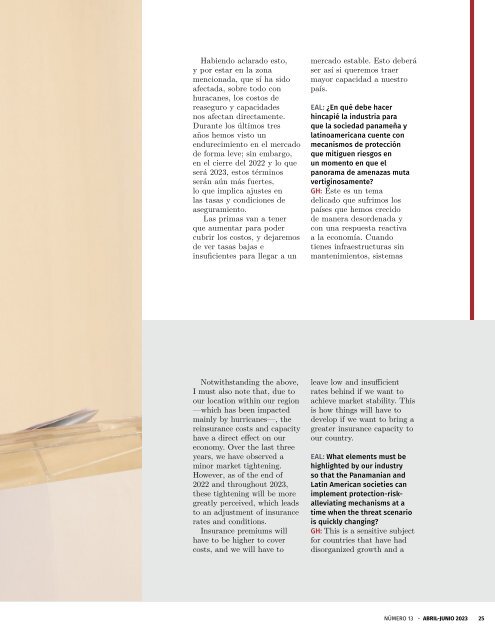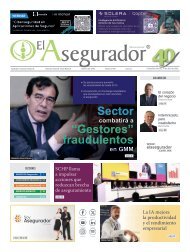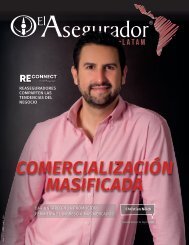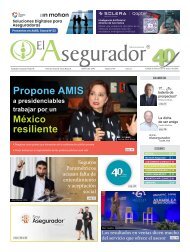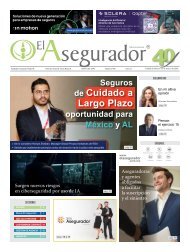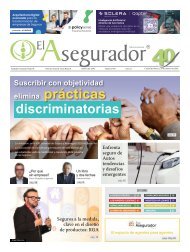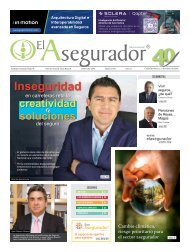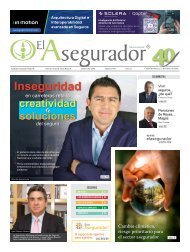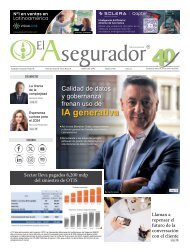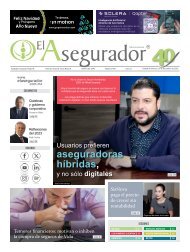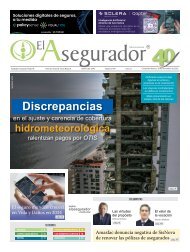El Asegurador LATAM Abr-Jun 23
En esta edición de El Asegurador LATAM conversamos con Gina Herrero, presidenta de la Asociación Panameña de Aseguradores (Apadea), quien profundiza sobre los ajustes que debe realizar el sector asegurador latinoamericano para aumentar su capacidad de aseguramiento. Además, contamos con una amplia cobertura de lo sucedido en la industria reaseguradora, tras sus eventos de inicio de año en Guatemala, México y Miami.
En esta edición de El Asegurador LATAM conversamos con Gina Herrero, presidenta de la Asociación Panameña de Aseguradores (Apadea), quien profundiza sobre los ajustes que debe realizar el sector asegurador latinoamericano para aumentar su capacidad de aseguramiento. Además, contamos con una amplia cobertura de lo sucedido en la industria reaseguradora, tras sus eventos de inicio de año en Guatemala, México y Miami.
You also want an ePaper? Increase the reach of your titles
YUMPU automatically turns print PDFs into web optimized ePapers that Google loves.
Habiendo aclarado esto,<br />
y por estar en la zona<br />
mencionada, que sí ha sido<br />
afectada, sobre todo con<br />
huracanes, los costos de<br />
reaseguro y capacidades<br />
nos afectan directamente.<br />
Durante los últimos tres<br />
años hemos visto un<br />
endurecimiento en el mercado<br />
de forma leve; sin embargo,<br />
en el cierre del 2022 y lo que<br />
será 20<strong>23</strong>, estos términos<br />
serán aún más fuertes,<br />
lo que implica ajustes en<br />
las tasas y condiciones de<br />
aseguramiento.<br />
Las primas van a tener<br />
que aumentar para poder<br />
cubrir los costos, y dejaremos<br />
de ver tasas bajas e<br />
insuficientes para llegar a un<br />
mercado estable. Esto deberá<br />
ser así si queremos traer<br />
mayor capacidad a nuestro<br />
país.<br />
EAL: ¿En qué debe hacer<br />
hincapié la industria para<br />
que la sociedad panameña y<br />
latinoamericana cuente con<br />
mecanismos de protección<br />
que mitiguen riesgos en<br />
un momento en que el<br />
panorama de amenazas muta<br />
vertiginosamente?<br />
GH: Éste es un tema<br />
delicado que sufrimos los<br />
países que hemos crecido<br />
de manera desordenada y<br />
con una respuesta reactiva<br />
a la economía. Cuando<br />
tienes infraestructuras sin<br />
mantenimientos, sistemas<br />
Notwithstanding the above,<br />
I must also note that, due to<br />
our location within our region<br />
—which has been impacted<br />
mainly by hurricanes—, the<br />
reinsurance costs and capacity<br />
have a direct effect on our<br />
economy. Over the last three<br />
years, we have observed a<br />
minor market tightening.<br />
However, as of the end of<br />
2022 and throughout 20<strong>23</strong>,<br />
these tightening will be more<br />
greatly perceived, which leads<br />
to an adjustment of insurance<br />
rates and conditions.<br />
Insurance premiums will<br />
have to be higher to cover<br />
costs, and we will have to<br />
leave low and insufficient<br />
rates behind if we want to<br />
achieve market stability. This<br />
is how things will have to<br />
develop if we want to bring a<br />
greater insurance capacity to<br />
our country.<br />
EAL: What elements must be<br />
highlighted by our industry<br />
so that the Panamanian and<br />
Latin American societies can<br />
implement protection-riskalleviating<br />
mechanisms at a<br />
time when the threat scenario<br />
is quickly changing?<br />
GH: This is a sensitive subject<br />
for countries that have had<br />
disorganized growth and a<br />
NÚMERO 13 - ABRIL-JUNIO 20<strong>23</strong> 25


